The Cambridge History of China. Vol. 13: Republican China 1912-1949, Part 2
Подождите немного. Документ загружается.

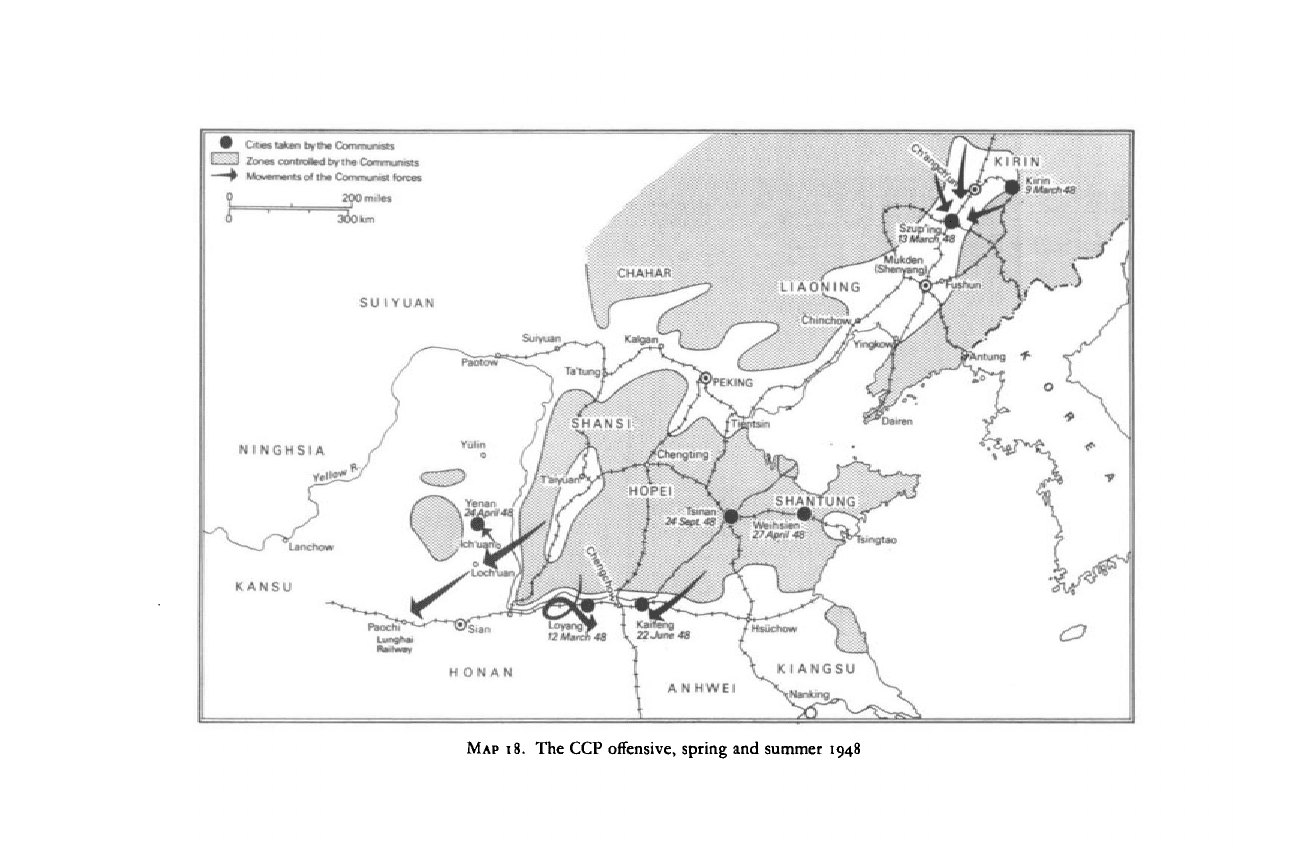
Cities taken
by
the Communists
iiiJ Zones controlled by the Communists
Movements of the Communist forces
200 miles
loOkm
NINGHSIA
KANSU
SU1
YUAN
Lunghfti
Railway
H
0
N
AN
MAP
18. The CCP offensive, spring and summer 1948
Cambridge Histories Online © Cambridge University Press, 2008
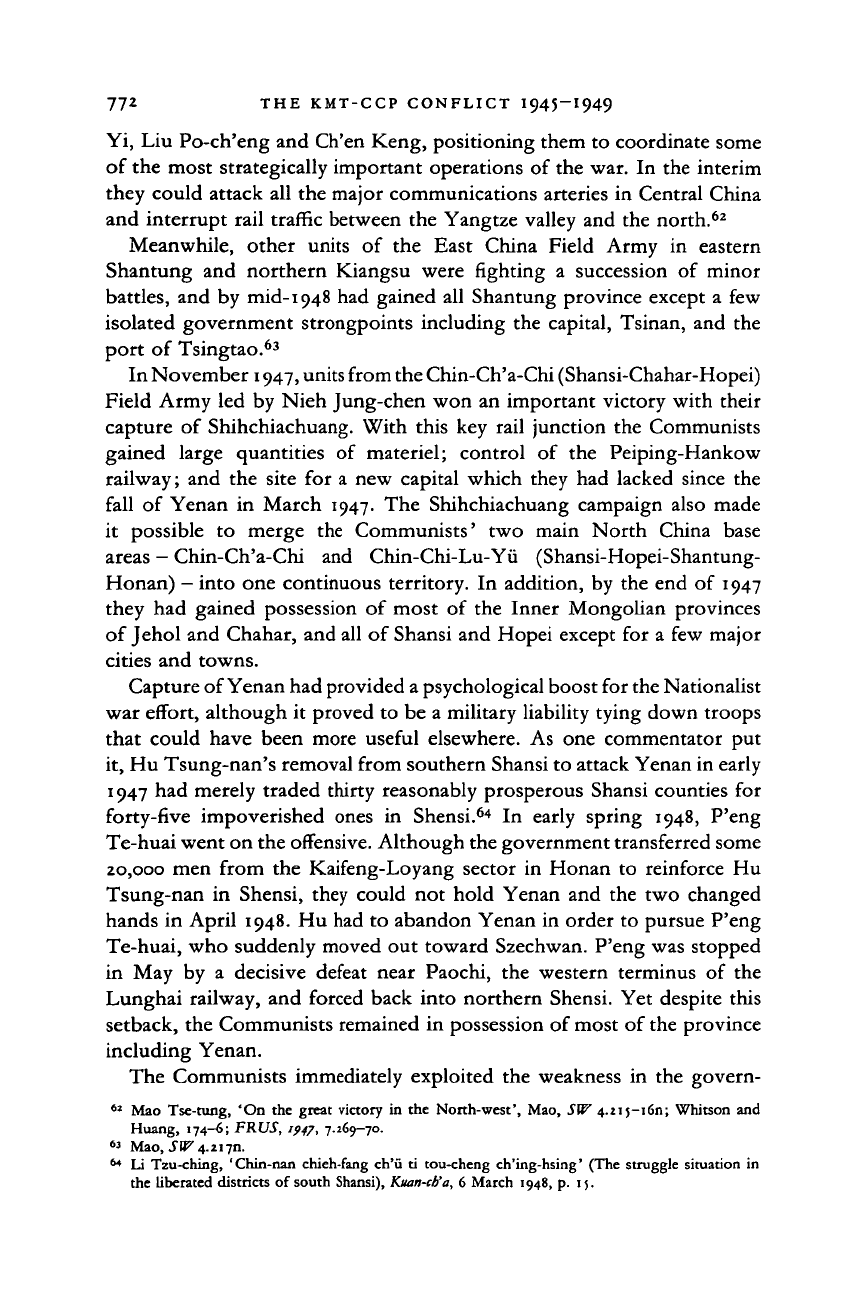
77
2
THE KMT-CCP CONFLICT I945-I949
Yi,
Liu Po-ch'eng and Ch'en Keng, positioning them to coordinate some
of the most strategically important operations of the war. In the interim
they could attack all the major communications arteries in Central China
and interrupt rail traffic between the Yangtze valley and the north.
62
Meanwhile, other units
of
the East China Field Army
in
eastern
Shantung and northern Kiangsu were fighting
a
succession
of
minor
battles, and by mid-1948 had gained all Shantung province except
a
few
isolated government strongpoints including the capital, Tsinan, and the
port of Tsingtao.
63
In November
1947,
units from the Chin-Ch'a-Chi (Shansi-Chahar-Hopei)
Field Army led by Nieh Jung-chen won an important victory with their
capture
of
Shihchiachuang. With this key rail junction the Communists
gained large quantities
of
materiel; control
of
the Peiping-Hankow
railway; and the site for a new capital which they had lacked since the
fall
of
Yenan
in
March 1947. The Shihchiachuang campaign also made
it possible
to
merge
the
Communists' two main North China base
areas
—
Chin-Ch'a-Chi
and
Chin-Chi-Lu-Yii (Shansi-Hopei-Shantung-
Honan)
—
into one continuous territory. In addition, by the end
of
1947
they had gained possession
of
most
of
the Inner Mongolian provinces
of Jehol and Chahar, and all of Shansi and Hopei except for a few major
cities and towns.
Capture of Yenan had provided a psychological boost for the Nationalist
war effort, although it proved to be a military liability tying down troops
that could have been more useful elsewhere. As one commentator put
it, Hu Tsung-nan's removal from southern Shansi to attack Yenan in early
1947 had merely traded thirty reasonably prosperous Shansi counties for
forty-five impoverished ones
in
Shensi.
64
In
early spring 1948, P'eng
Te-huai went on the offensive. Although the government transferred some
20,000 men from the Kaifeng-Loyang sector in Honan to reinforce Hu
Tsung-nan
in
Shensi, they could not hold Yenan and the two changed
hands in April 1948. Hu had to abandon Yenan in order to pursue P'eng
Te-huai, who suddenly moved out toward Szechwan. P'eng was stopped
in May by
a
decisive defeat near Paochi, the western terminus
of
the
Lunghai railway, and forced back into northern Shensi. Yet despite this
setback, the Communists remained in possession of most of the province
including Yenan.
The Communists immediately exploited the weakness
in
the govern-
62
Mao Tse-tung, 'On the great victory
in
the North-west', Mao,
SW
4.2ij-i6n; Whitson and
Huang, 174-6; FRUS, 1947, 7.269-70.
63
Mao,
SW
4.117T1.
64
Li
Tzu-ching, 'Chin-nan chieh-fang ch'u
ti
tou-cheng ch'ing-hsing' (The struggle situation
in
the liberated districts
of
south Shansi), Kuan-d'a,
6
March 1948,
p. 15.
Cambridge Histories Online © Cambridge University Press, 2008

THE CIVIL
WAR
1946-1949
773
ment's Honan defences, created
by the
transfer
of
forces into Shensi,
by
moving against Loyang
on the
Lunghai railway.
The
city changed hands
three times, ending
in
victory
for
Ch'en Keng's forces
in
early April 1948.
CCP units were then
in a
position
to
capture Linfen,
the
last government
stronghold
in
southern Shansi,
in
mid-May, linking
up the
Communist
areas
of
Shansi with those
of Liu
Po-ch'eng's base
in
Central China.
By
the end of the month the
armies
of Ch'en
Yi,
Ch'en Keng and Liu Po-ch'eng,
under
the
overall command
of
Ch'en
Yi, had
converged
on
Kaifeng
in
a coordinated operation that lasted
for
several weeks. They occupied
the
city, capital
of
Honan,
in
mid-June. Although Ch'en
Yi's
forces could
not hold Kaifeng and were actually defeated in a subsequent battle nearby,
the Loyang-Kaifeng campaigns were major turning points
in
the war.
The
Communist armies
had
demonstrated their ability
to
sustain
the
offensive
on several fronts simultaneously,
and to
engage
in
large-scale positional
battles
in
open country,
the
final
step
in
moving from guerrilla operations
to mobile warfare.
And
whereas previously
the
main fighting
had
been
in Shantung
and
Manchuria,
now the
Loyang-Kaifeng operations,
following close upon those
at
Shihchiachuang
and
Yenan,
had
created
a major
new
battle zone
in
North China. These victories also made
possible
the
expansion
and
unification
of
hitherto separate Communist
border regions.
The
Shansi-Chahar-Hopei
and the
Shansi-Hopei-
Shantung-Honan Border Regions were merged into
the
North China
Liberated Area in May 1948.
A
unified North China People's government
was established
in
August with
its
capital
at
Shihchiachuang.
65
The
North-east.
One
final turning point
by
mid-1948
was the
reversal
of
the power balance
in
Manchuria. September 1947 brought the start
of
Lin
Piao's sixth offensive across
the
Sungari, aimed this time
to
isolate
completely
the
major cities
of
central
and
south Manchuria
and cut
land
communications with North China
by
severing
the
Peiping-Mukden
railway line. These goals were essentially achieved
by the end of
November.
66
Preliminary attacks heralding
the
onset
of the
seventh
offensive began
in
mid-December. Command
of
Nationalist forces
in the
North-east passed from Ch'en Ch'eng
to
General Wei Li-huang.
But Lin
Piao
was now
strong enough
to
attack
on
three fronts simultaneously.
At
the
start
of his
seventh offensive, Communist forces converged
on
Mukden from the north, west and south. When reinforcements were flown
into
the
city from Changchun
and
Kirin, however,
Lin
immediately
65
Civil
war
in
China, 144-53; Military campaigns, 145-52; Chassin, Communist conquest, 168-77;
Mao
Tse-tung,
'A
circular
on
the
situation', Mao,
SW
4.22611.
66
FRUS, 1)4/, 7.257-8, 270-1, 287-8, 290, 298, 302, 306-8, 315-20, 356-8, 362-3, 373-80.
Cambridge Histories Online © Cambridge University Press, 2008
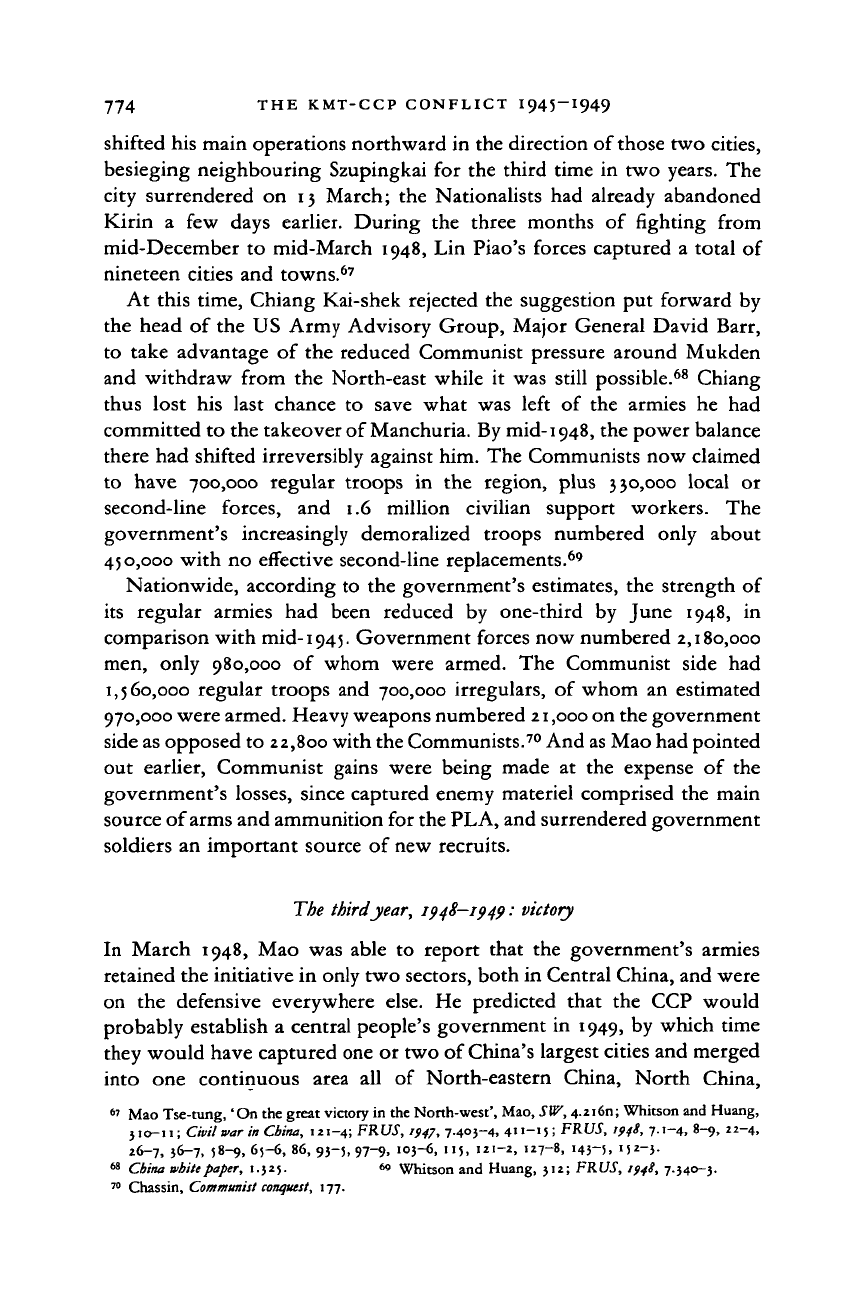
774 THE KMT-CCP CONFLICT I945-I949
shifted his main operations northward in the direction of those two cities,
besieging neighbouring Szupingkai for the third time
in
two years. The
city surrendered
on
13 March; the Nationalists had already abandoned
Kirin
a few
days earlier. During
the
three months
of
fighting from
mid-December
to
mid-March 1948, Lin Piao's forces captured
a
total of
nineteen cities and towns.
67
At this time, Chiang Kai-shek rejected the suggestion put forward by
the head
of
the US Army Advisory Group, Major General David Barr,
to take advantage
of
the reduced Communist pressure around Mukden
and withdraw from the North-east while
it
was still possible.
68
Chiang
thus lost
his
last chance
to
save what was left
of
the armies
he had
committed to the takeover of Manchuria. By mid-1948, the power balance
there had shifted irreversibly against him. The Communists now claimed
to have 700,000 regular troops
in the
region, plus 330,000 local
or
second-line forces,
and 1.6
million civilian support workers.
The
government's increasingly demoralized troops numbered only about
450,000 with no effective second-line replacements.
69
Nationwide, according to the government's estimates, the strength of
its regular armies
had
been reduced
by
one-third
by
June 1948,
in
comparison with mid-1945. Government forces now numbered 2,180,000
men, only 980,000
of
whom were armed.
The
Communist side
had
1,560,000
regular troops and 700,000 irregulars,
of
whom
an
estimated
970,000 were armed. Heavy weapons numbered 21,000 on the government
side as opposed to 22,800 with the Communists.
70
And as Mao had pointed
out earlier, Communist gains were being made
at the
expense
of
the
government's losses, since captured enemy materiel comprised the main
source of arms and ammunition for the PLA, and surrendered government
soldiers an important source of new recruits.
The third year, 1948-1949: victory
In March 1948, Mao was able
to
report that the government's armies
retained the initiative in only two sectors, both in Central China, and were
on
the
defensive everywhere else.
He
predicted that
the
CCP would
probably establish
a
central people's government in 1949, by which time
they would have captured one or two of China's largest cities and merged
into
one
continuous area
all of
North-eastern China, North China,
67
Mao
Tse-tung,
'On the
great victory
in the
North-west',
Mao,
SW,
4.2i6n;
Whitson
and
Huang,
3 IO-I
1;
Civil
war in
China,
i
2
1-4;
FRUS,
1947,
7403-4,
411-15;
FRUS,
194S,
7.1-4,
8-9, 22-4,
26-7, 36-7, 58-9, 65-6, 86, 93-5, 97-9,
103-6,
115,
121-2,
127-8,
143-5,
152-3.
68
China white paper, 1.325.
to
Whitson and Huang, 312; FRUS, 1948, 7.340-3.
70
Chassin, Communist
conquest,
177.
Cambridge Histories Online © Cambridge University Press, 2008
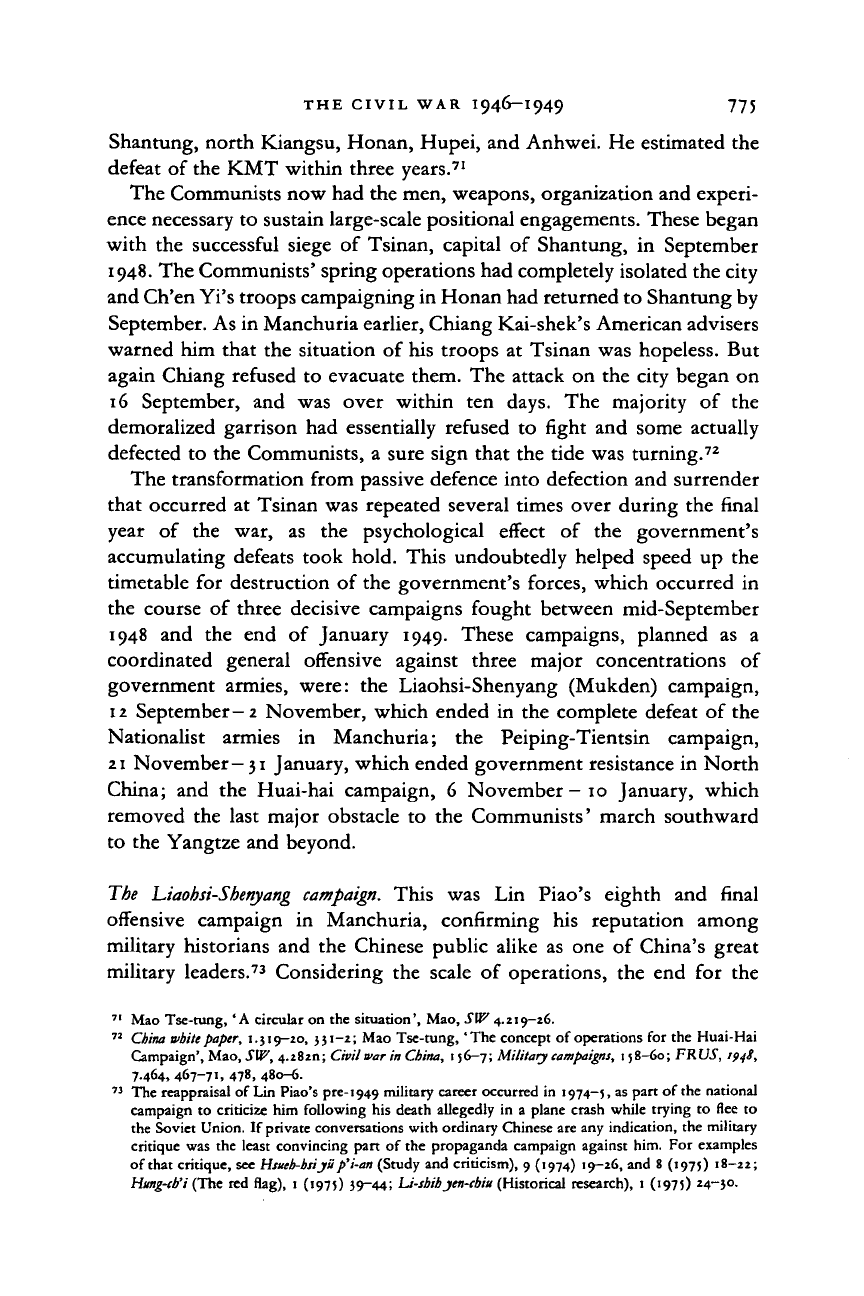
THE CIVIL WAR I946-I949 775
Shantung, north Kiangsu, Honan, Hupei, and Anhwei. He estimated the
defeat of the KMT within three years.
71
The Communists now had the men, weapons, organization and experi-
ence necessary to sustain large-scale positional engagements. These began
with the successful siege of Tsinan, capital of Shantung, in September
1948.
The Communists' spring operations had completely isolated the city
and Ch'en Yi's troops campaigning in Honan had returned to Shantung by
September. As in Manchuria earlier, Chiang Kai-shek's American advisers
warned him that the situation of his troops at Tsinan was hopeless. But
again Chiang refused to evacuate them. The attack on the city began on
16 September, and was over within ten days. The majority of the
demoralized garrison had essentially refused to fight and some actually
defected to the Communists, a sure sign that the tide was turning.
72
The transformation from passive defence into defection and surrender
that occurred at Tsinan was repeated several times over during the final
year of the war, as the psychological effect of the government's
accumulating defeats took hold. This undoubtedly helped speed up the
timetable for destruction of the government's forces, which occurred in
the course of three decisive campaigns fought between mid-September
1948 and the end of January 1949. These campaigns, planned as a
coordinated general offensive against three major concentrations of
government armies, were: the Liaohsi-Shenyang (Mukden) campaign,
12 September-2 November, which ended in the complete defeat of the
Nationalist armies in Manchuria; the Peiping-Tientsin campaign,
21 November-31 January, which ended government resistance in North
China; and the Huai-hai campaign, 6 November-10 January, which
removed the last major obstacle to the Communists' march southward
to the Yangtze and beyond.
The
'Liaohsi-Shenyang
campaign.
This was Lin Piao's eighth and final
offensive campaign in Manchuria, confirming his reputation among
military historians and the Chinese public alike as one of China's great
military leaders.
73
Considering the scale of operations, the end for the
71
Mao
Tse-tung,
'A
circular
on
the situation', Mao,
SW
4.219—26.
72
China white
paper,
1.319-20,
331-2; Mao Tse-tung, 'The concept of operations for the Huai-Hai
Campaign', Mao, SV,
4.28211;
Civil
war in
China,
156—7;
Military
campaigns,
158-60; FRUS, 194!,
7.464,467-71,478.480-6.
73
The reappraisal
of
Lin Piao's pre-1949 military career occurred
in
1974-5,
as
part
of
the national
campaign
to
criticize
him
following
his
death allegedly
in a
plane crash while trying
to
flee
to
the Soviet Union.
If
private conversations with ordinary Chinese are any indication, the military
critique
was the
least convincing part
of
the propaganda campaign against him.
For
examples
of that critique, see Hsueh-hsijup'i-an (Study
and
criticism),
9
(1974) 19-26, and
8
(1975) 18-22;
Huitg-ch'i (The
red
flag),
1
(1975) 39—44;
U-shibjen-cbiu
(Historical research),
1
('97?)
*4~1°-
Cambridge Histories Online © Cambridge University Press, 2008
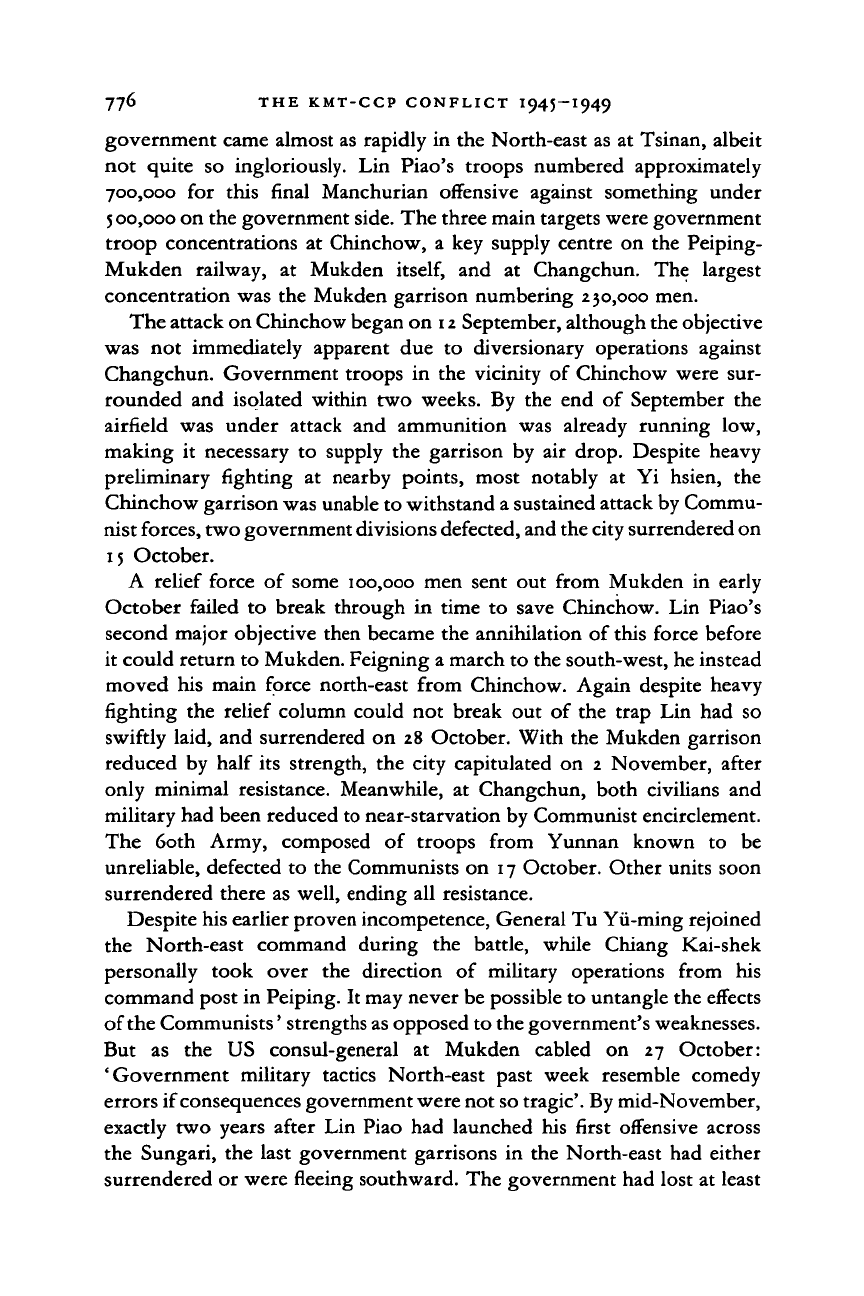
77^
THE KMT-CCP CONFLICT I945-I949
government came almost as rapidly in the North-east as at Tsinan, albeit
not quite
so
ingloriously.
Lin
Piao's troops numbered approximately
700,000
for
this final Manchurian offensive against something under
500,000 on the government side. The three main targets were government
troop concentrations
at
Chinchow,
a
key supply centre on the Peiping-
Mukden railway,
at
Mukden
itself,
and at
Changchun.
The
largest
concentration was the Mukden garrison numbering 230,000 men.
The attack on Chinchow began on 12 September, although the objective
was
not
immediately apparent due
to
diversionary operations against
Changchun. Government troops
in
the vicinity
of
Chinchow were sur-
rounded and isolated within two weeks. By the end
of
September the
airfield was under attack
and
ammunition was already running
low,
making
it
necessary
to
supply the garrison
by air
drop. Despite heavy
preliminary fighting
at
nearby points, most notably
at Yi
hsien,
the
Chinchow garrison was unable to withstand a sustained attack by Commu-
nist forces, two government divisions defected, and the city surrendered on
15 October.
A relief force
of
some 100,000 men sent out from Mukden
in
early
October failed
to
break through
in
time
to
save Chinchow. Lin Piao's
second major objective then became the annihilation of this force before
it could return to Mukden. Feigning a march to the south-west, he instead
moved his main force north-east from Chinchow. Again despite heavy
fighting the relief column could not break out
of
the trap Lin had
so
swiftly laid, and surrendered on 28 October. With the Mukden garrison
reduced
by
half its strength, the city capitulated
on 2
November, after
only minimal resistance. Meanwhile,
at
Changchun, both civilians and
military had been reduced to near-starvation by Communist encirclement.
The 60th Army, composed
of
troops from Yunnan known
to be
unreliable, defected to the Communists on 17 October. Other units soon
surrendered there as well, ending all resistance.
Despite his earlier proven incompetence, General Tu Yii-ming rejoined
the North-east command during
the
battle, while Chiang Kai-shek
personally took over
the
direction
of
military operations from
his
command post in Peiping. It may never be possible to untangle the effects
of the Communists' strengths as opposed to the government's weaknesses.
But
as the US
consul-general
at
Mukden cabled
on 27
October:
'Government military tactics North-east past week resemble comedy
errors if consequences government were not so tragic'. By mid-November,
exactly two years after Lin Piao had launched his first offensive across
the Sungari, the last government garrisons
in
the North-east had either
surrendered or were fleeing southward. The government had lost at least
Cambridge Histories Online © Cambridge University Press, 2008
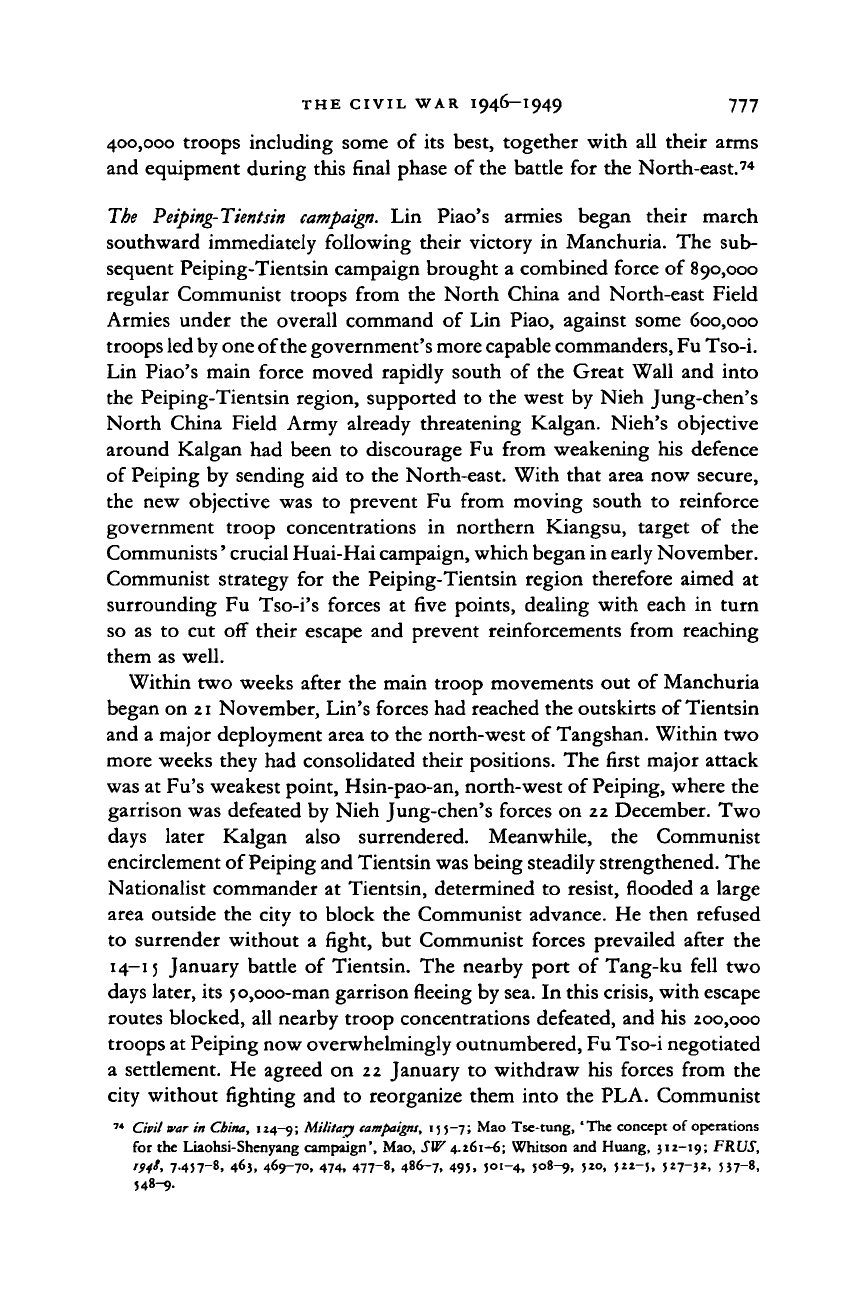
THE CIVIL WAR 1946—1949 777
400,000 troops including some of its best, together with all their arms
and equipment during this final phase of the battle for the North-east.
74
The
Peiping-Tientsin
campaign.
Lin Piao's armies began their march
southward immediately following their victory in Manchuria. The sub-
sequent Peiping-Tientsin campaign brought a combined force of 890,000
regular Communist troops from the North China and North-east Field
Armies under the overall command of Lin Piao, against some 600,000
troops led by one of the government's more capable commanders, Fu Tso-i.
Lin Piao's main force moved rapidly south of the Great Wall and into
the Peiping-Tientsin region, supported to the west by Nieh Jung-chen's
North China Field Army already threatening Kalgan. Nieh's objective
around Kalgan had been to discourage Fu from weakening his defence
of Peiping by sending aid to the North-east. With that area now secure,
the new objective was to prevent Fu from moving south to reinforce
government troop concentrations in northern Kiangsu, target of the
Communists' crucial Huai-Hai campaign, which began in early November.
Communist strategy for the Peiping-Tientsin region therefore aimed at
surrounding Fu Tso-i's forces at five points, dealing with each in turn
so as to cut off their escape and prevent reinforcements from reaching
them as well.
Within two weeks after the main troop movements out of Manchuria
began on
21
November, Lin's forces had reached the outskirts of Tientsin
and a major deployment area to the north-west of Tangshan. Within two
more weeks they had consolidated their positions. The first major attack
was at Fu's weakest point, Hsin-pao-an, north-west of Peiping, where the
garrison was defeated by Nieh Jung-chen's forces on 22 December. Two
days later Kalgan also surrendered. Meanwhile, the Communist
encirclement of Peiping and Tientsin was being steadily strengthened. The
Nationalist commander at Tientsin, determined to resist, flooded a large
area outside the city to block the Communist advance. He then refused
to surrender without a fight, but Communist forces prevailed after the
14-15 January battle of Tientsin. The nearby port of Tang-ku fell two
days later, its 50,000-man garrison fleeing by sea. In this crisis, with escape
routes blocked, all nearby troop concentrations defeated, and his 200,000
troops at Peiping now overwhelmingly outnumbered, Fu Tso-i negotiated
a settlement. He agreed on 22 January to withdraw his forces from the
city without fighting and to reorganize them into the PLA. Communist
74
Civil
war
in
China,
124-9;
Military
campaigns,
155-7; Mao Tse-tung,
'
The concept of operations
for the Liaohsi-Shenyang campaign', Mao, SW 4.261-6; Whitson and Huang, 312-19; FRUS,
194I, 7.457-8, 463, 469-7°. 474, 477-8, 486-7, 495, 501-4, 508-9, 520, 522-5, 527-32, 537-8,
548-9.
Cambridge Histories Online © Cambridge University Press, 2008
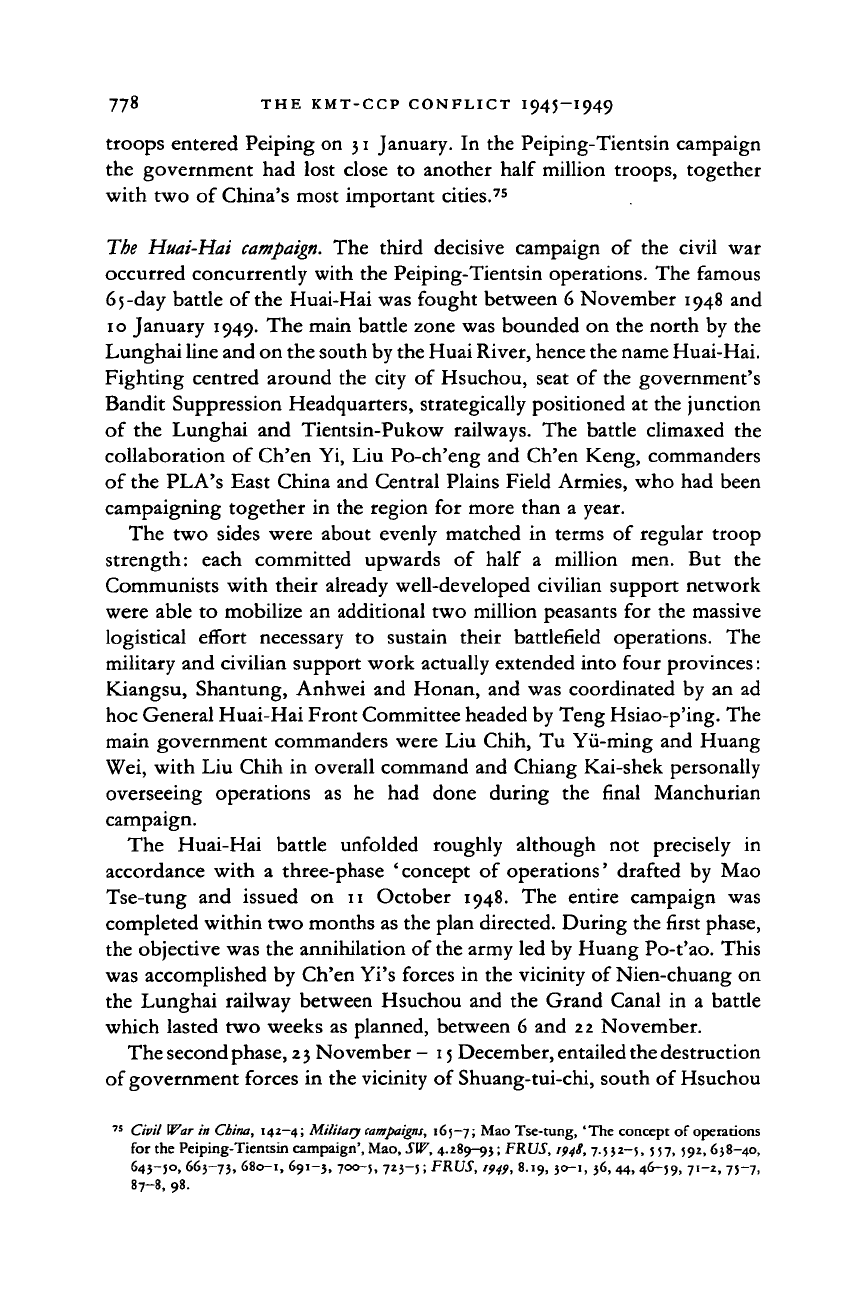
778 THE KMT-CCP CONFLICT 1945-1949
troops entered Peiping on 31 January. In the Peiping-Tientsin campaign
the government had lost close
to
another half million troops, together
with two
of
China's most important cities.
75
The Huai-Hai
campaign.
The
third decisive campaign
of the
civil
war
occurred concurrently with the Peiping-Tientsin operations. The famous
6
5-day
battle of the Huai-Hai was fought between 6 November 1948 and
10 January 1949. The main battle zone was bounded on the north by the
Lunghai line and on the south by the Huai River, hence the name Huai-Hai.
Fighting centred around the city
of
Hsuchou, seat
of
the government's
Bandit Suppression Headquarters, strategically positioned at the junction
of the Lunghai
and
Tientsin-Pukow railways. The battle climaxed
the
collaboration
of
Ch'en Yi, Liu Po-ch'eng and Ch'en Keng, commanders
of the PLA's East China and Central Plains Field Armies, who had been
campaigning together in the region for more than
a
year.
The two sides were about evenly matched
in
terms
of
regular troop
strength: each committed upwards
of
half
a
million men.
But the
Communists with their already well-developed civilian support network
were able
to
mobilize an additional two million peasants for the massive
logistical effort necessary
to
sustain their battlefield operations.
The
military and civilian support work actually extended into four provinces:
Kiangsu, Shantung, Anhwei and Honan, and was coordinated by an ad
hoc General Huai-Hai Front Committee headed by Teng Hsiao-p'ing. The
main government commanders were Liu Chih, Tu Yii-ming and Huang
Wei, with Liu Chih in overall command and Chiang Kai-shek personally
overseeing operations
as he had
done during
the
final Manchurian
campaign.
The Huai-Hai battle unfolded roughly although
not
precisely
in
accordance with
a
three-phase ' concept
of
operations' drafted
by
Mao
Tse-tung
and
issued
on 11
October 1948.
The
entire campaign
was
completed within two months as the plan directed. During the first phase,
the objective was the annihilation of the army led by Huang Po-t'ao. This
was accomplished by Ch'en Yi's forces in the vicinity of Nien-chuang on
the Lunghai railway between Hsuchou and the Grand Canal
in a
battle
which lasted two weeks as planned, between 6 and 22 November.
The second
phase,
23
November
-
15
December, entailed the destruction
of government forces in the vicinity of Shuang-tui-chi, south of Hsuchou
75
Civil War in
China,
142-4;
Military
campaigns,
165-7; Mao Tse-tung, 'The concept of operations
for the Peiping-Tientsin campaign', Mao, SW, 4.289-95; FRUS,
194!,
7.532-5, 557, 592,638-40,
643-50, 663-73,
680-1,
691—3, 700-5,
723—5;
FRUS,
1949,
8.19, 30-1, 36, 44, 46-59, 71-2, 75-7,
87-8,
98.
Cambridge Histories Online © Cambridge University Press, 2008
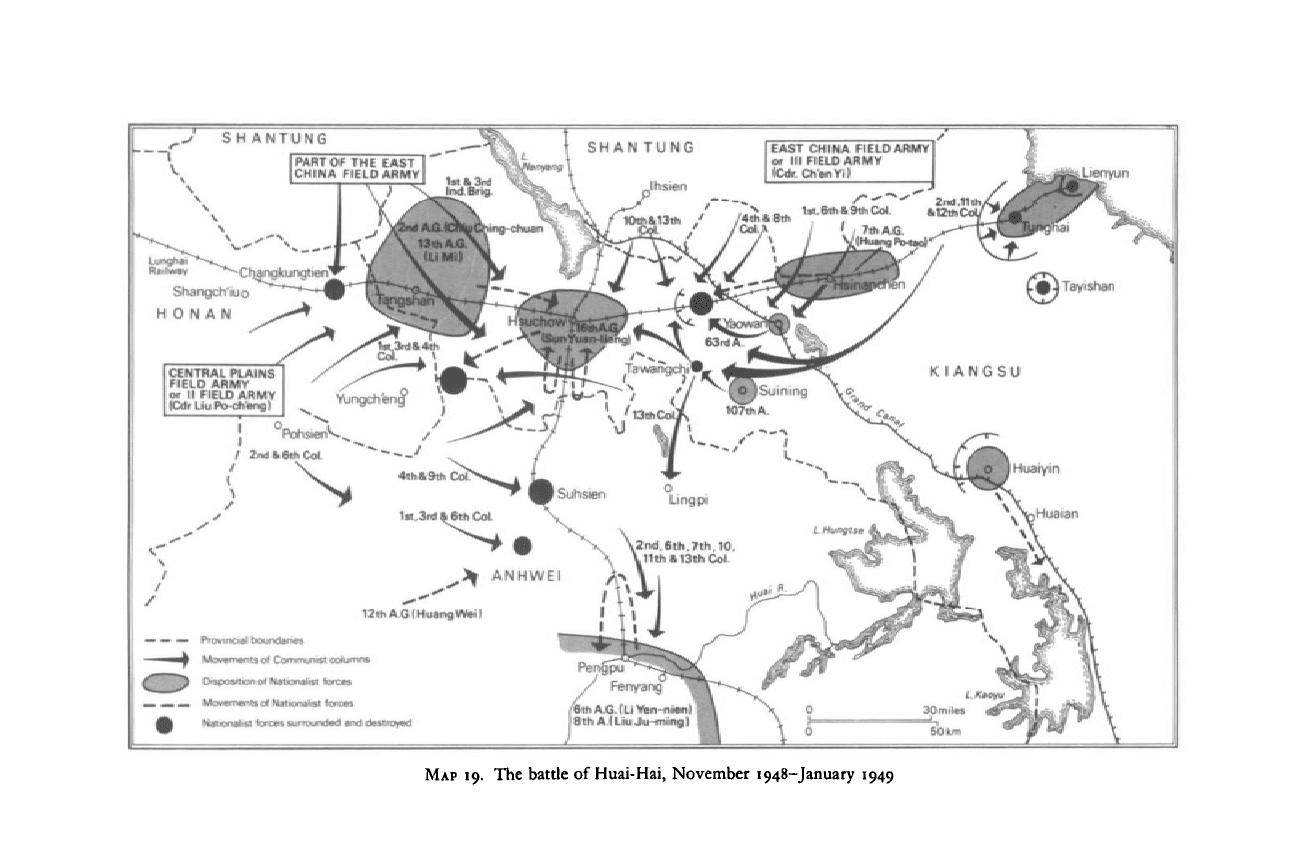
EAST CHINA FIELD ARMY
or III FIELD ARMY
(Cdr. Ch'enYi)
PART OF THE EAST
CHINA FIELD ARMY
Chsngkungtien
Shangch'iuo
HONAN
(
Tawangchi»_ ,
CENTRAL PLAINS
FIELD ARMY
or II FIELD ARMY
(CdrUuPo-crTeng)
12th A.G (Huang Wei)
— _ _ Provincial boundaries
Movements of Communist columns
^^^^P Disposition of Nationalist forces
. ._ Movements of Nationalist forces
Nationalist
forces surrounded
and destroyed
6thA.G.(LiYen-nien)
8th A.ILiuJu-mingl
MAP
19. The battle of Huai-Hai, November 1948-January 1949
Cambridge Histories Online © Cambridge University Press, 2008
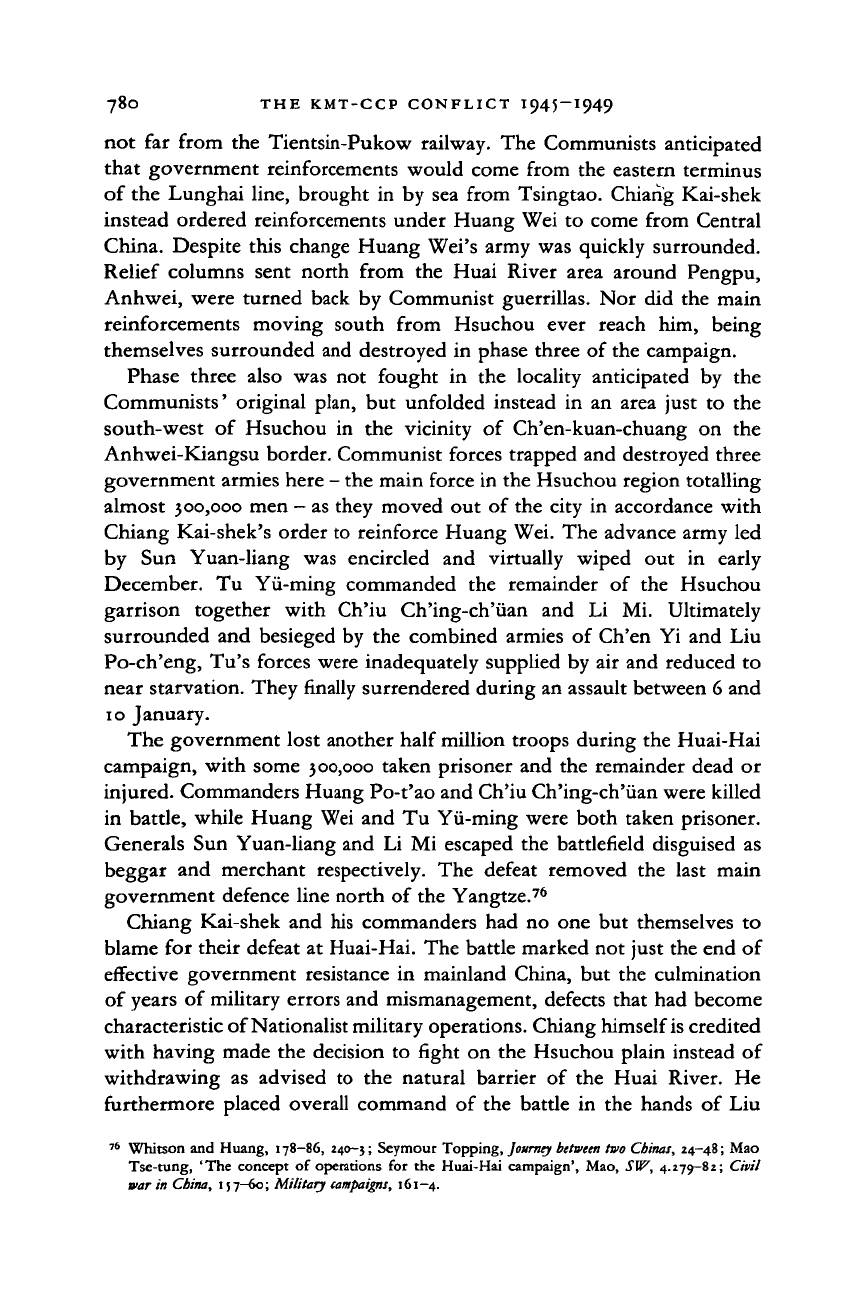
780 THE KMT-CCP CONFLICT I945-I949
not far from the Tientsin-Pukow railway. The Communists anticipated
that government reinforcements would come from the eastern terminus
of the Lunghai line, brought in by sea from Tsingtao. Chiang Kai-shek
instead ordered reinforcements under Huang Wei to come from Central
China. Despite this change Huang Wei's army was quickly surrounded.
Relief columns sent north from the Huai River area around Pengpu,
Anhwei, were turned back by Communist guerrillas. Nor did the main
reinforcements moving south from Hsuchou ever reach him, being
themselves surrounded and destroyed in phase three of the campaign.
Phase three also was not fought
in
the locality anticipated
by
the
Communists' original plan, but unfolded instead
in
an area just
to
the
south-west
of
Hsuchou
in
the vicinity
of
Ch'en-kuan-chuang
on the
Anhwei-Kiangsu border. Communist forces trapped and destroyed three
government armies here
-
the main force in the Hsuchou region totalling
almost 300,000 men
-
as they moved out of the city in accordance with
Chiang Kai-shek's order to reinforce Huang Wei. The advance army led
by
Sun
Yuan-liang was encircled
and
virtually wiped
out in
early
December.
Tu
Yu-ming commanded
the
remainder
of
the Hsuchou
garrison together with Ch'iu Ch'ing-ch'iian
and Li
Mi. Ultimately
surrounded and besieged by the combined armies of Ch'en Yi and Liu
Po-ch'eng, Tu's forces were inadequately supplied by air and reduced to
near starvation. They finally surrendered during an assault between 6 and
10 January.
The government lost another half million troops during the Huai-Hai
campaign, with some 300,000 taken prisoner and the remainder dead or
injured. Commanders Huang Po-t'ao and Ch'iu Ch'ing-ch'iian were killed
in battle, while Huang Wei and Tu Yu-ming were both taken prisoner.
Generals Sun Yuan-liang and Li Mi escaped the battlefield disguised as
beggar and merchant respectively. The defeat removed the last main
government defence line north of the Yangtze.
76
Chiang Kai-shek and his commanders had no one but themselves
to
blame for their defeat at Huai-Hai. The battle marked not just the end of
effective government resistance in mainland China, but the culmination
of years of military errors and mismanagement, defects that had become
characteristic of Nationalist military operations. Chiang himself is credited
with having made the decision to fight on the Hsuchou plain instead of
withdrawing
as
advised
to
the natural barrier
of
the Huai River.
He
furthermore placed overall command
of
the battle
in
the hands
of
Liu
76
Whitson and Huang, 178—86,
240-3;
Seymour Topping,
Journey between
two
Chinas,
24-48; Mao
Tse-tung, "The concept
of
operations for the Huai-Hai campaign', Mao, SW, 4.279-82; Civil
war in China, 157-60; Military campaigns, 161—4.
Cambridge Histories Online © Cambridge University Press, 2008
